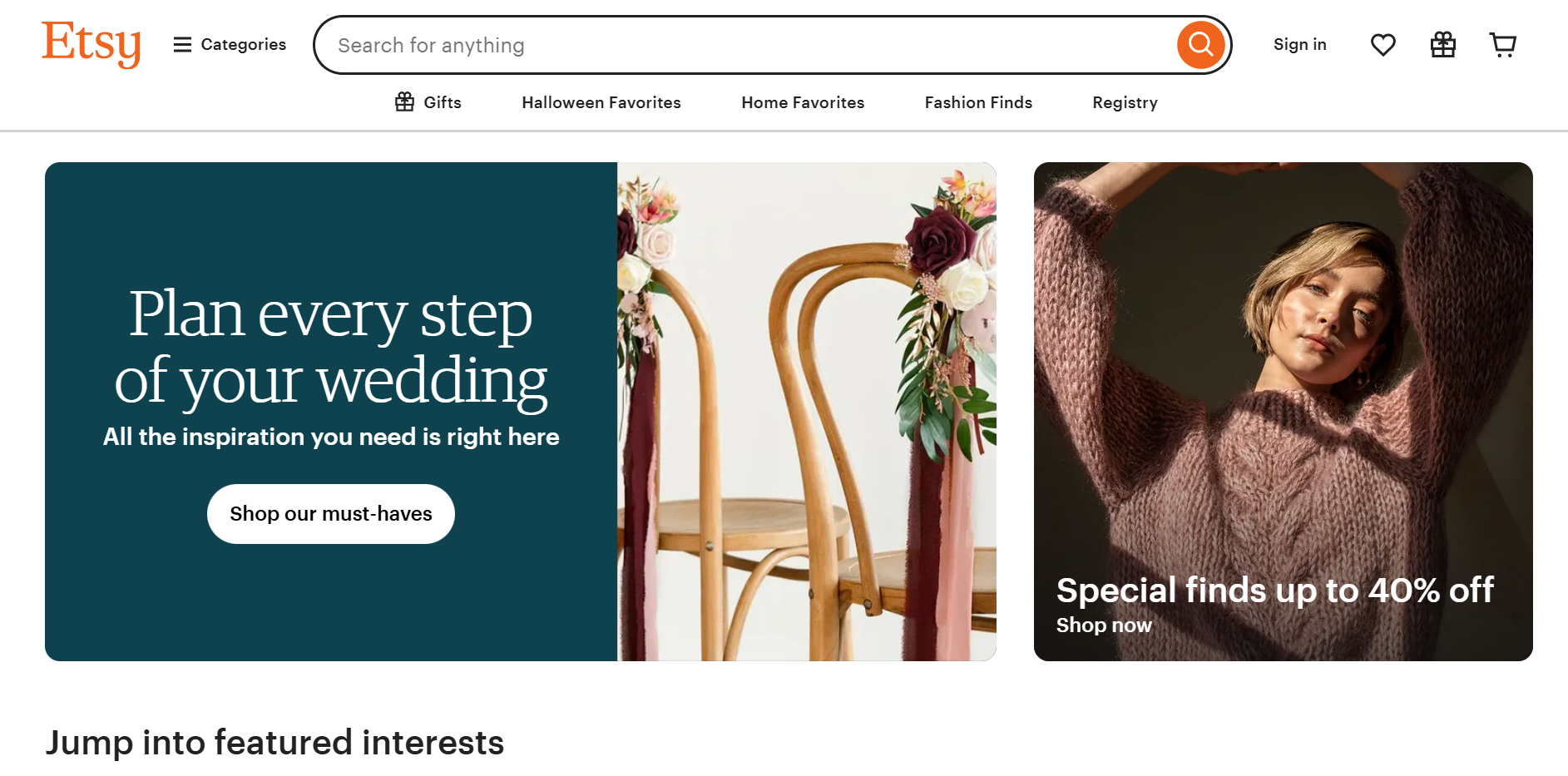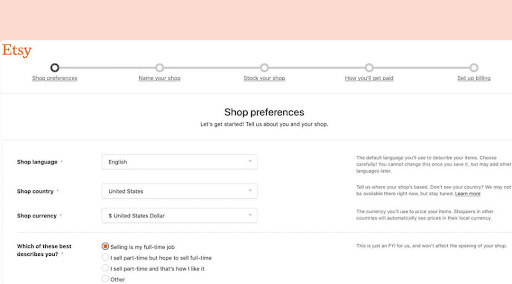
What is Etsy? How to sell on Etsy & how it differs from Amazon
What is Etsy and why has it become the leading platform for handmade and creative products? This article will analyze in detail how to sell on Etsy and compare its differences with Amazon, helping businesses and individuals seize opportunities to expand their global business effectively.
1. What Is Etsy and Why Is It So Popular?
Understanding Etsy’s history, brand positioning, and differentiating factors helps businesses fully evaluate the platform’s value, thereby determining its suitability for their products, brands, and long-term business strategies.
1.1. What Is Etsy?
Etsy is a global e-commerce platform known for its unique handmade products, valuable vintage items, and creative art supplies. It serves as a marketplace where artisans, crafters, and small shop owners can showcase distinctive and creative products to customers around the world.
This makes Etsy stand out from other mass-market e-commerce platforms. It is not only a sales channel but also a space that celebrates individuality, creativity, and personalization in every product.
1.2. Etsy’s Development History and Brand Positioning
Etsy was founded in 2005 by Robert Kalin, Chris Maguire, and Haim Schoppik in Brooklyn, New York. Initially, it was a small website where artisans could showcase creative products with strong personal touches.
After just a few years, Etsy quickly expanded its scale, attracting millions of small sellers globally. Today, it has become one of the largest e-commerce platforms dedicated to handmade and creative products.

According to Statista (2024), Etsy recorded around 95 million active buyers, a clear indicator of the strong appeal of its business model built around uniqueness and creativity.
The key difference in Etsy’s development journey lies in its brand positioning. Etsy is not just an intermediary marketplace—it is a community space where creativity and culture are nurtured and shared. With its philosophy of “mindful commerce,” every product on Etsy carries not only functional value but also a story and a personal mark from the artisan.
1.3. What Makes Etsy Different from Other E-Commerce Platforms?
Several factors make Etsy more appealing to both buyers and sellers:
- Focus on handmade/vintage products: Etsy’s listings emphasize personalized, emotionally rich, and one-of-a-kind items—something large marketplaces like Amazon find difficult to maintain due to their mass-production nature.
- Search and discovery experience: Etsy offers an intuitive interface and detailed filters by material, style, and target audience. Buyers appreciate the sense of “discovery” when browsing Etsy rather than simply making quick purchases.
- A strong creative community: Customers on Etsy seek not only products but also the stories behind them. This gives small brands, artisans, and independent designers a clear advantage when selling on Etsy.
- Reasonable listing and commission fees: With affordable fees suitable for individuals and small businesses, Etsy allows sellers to experiment without the heavy financial burden often associated with global e-commerce platforms.
Etsy is not merely a marketplace—it’s a community that celebrates creativity, where small brands can stand out through differentiation. With unique products, authentic stories, and the right strategy, Etsy can become a sustainable growth platform for Vietnamese brands.
2. Should You Sell on Etsy? Practical Benefits and Challenges
Etsy opens doors for handmade, vintage, and artistic products to reach a global audience. However, alongside opportunities, sellers also face various challenges in the process.
2.1. Benefits of Selling on Etsy
The most notable strength of Etsy lies in its ability to connect with a global customer base that values uniqueness and individuality. Unlike platforms that focus on mass-produced goods, Etsy thrives on offering finely crafted handmade items.
Another advantage is personalization—each product can be customized to match a buyer’s preferences, needs, and identity. As a result, every item on Etsy is not just a product but a one-of-a-kind creation carrying emotional and personal value. This allows sellers to find customers who genuinely appreciate creativity and are willing to pay higher prices, helping sellers boost profit margins without competing solely on price.

Additionally, Etsy provides numerous tools such as Etsy Ads, Shop Analytics, and Etsy Storefronts to help sellers build professional brand images and optimize visibility.
2.2. Common Challenges When Selling on Etsy
Despite these advantages, selling on Etsy also presents challenges. Increasing competition makes it difficult for new sellers to stand out. Optimizing SEO for listings, creating high-quality product images, and maintaining positive reviews are essential survival factors.
Moreover, fees such as listing costs, transaction commissions, and advertising expenses must be carefully calculated. For sellers from Vietnam, international logistics and shipping costs are crucial considerations.
In short, Etsy offers both global opportunities and operational challenges. Understanding what Etsy is, along with its pros and cons, will help sellers navigate the platform more effectively.
3. How to Sell on Etsy for Beginners
Etsy is not just for selling handmade or vintage goods—it’s also a gateway for Vietnamese sellers to reach international markets. However, to sell effectively, beginners must understand the basic steps from setting up a seller account to managing daily operations.
3.1. Create an Etsy Seller Account and Set Up Your Shop
The first step is to register an Etsy Seller account. Sellers need to provide personal details, bank information for payments, and choose a preferred currency.

Next, set up your shop by naming it, adding a logo, and writing a concise yet engaging shop description. A well-presented shop creates a positive first impression and increases customer trust.
3.2. Listing Products and Optimizing Visibility on Etsy
Once your shop is created, the next step is to add products. Each listing should have a clear title, include keywords such as “Etsy” and product-related terms. The description must provide details about materials, dimensions, usage, and the story behind the item—since Etsy buyers value personalization.
High-quality images, taken in natural light from multiple angles, are crucial for credibility. Using accurate tags and categories also enhances discoverability. Proper SEO optimization ensures your products appear in search results.
3.3. Managing Orders, Shipping, and Customer Service
Once you start receiving orders, prompt and transparent order handling is key. Efficient shipping management and providing tracking information help reduce disputes. Vietnamese sellers should use reputable international shipping services to ensure delivery times.
Equally important is customer care—responding quickly to messages, addressing concerns, and maintaining good communication improve customer satisfaction and ratings. On Etsy, customer feedback directly affects visibility and reputation.
Mastering these basics—from account setup to listing optimization and operations—lays a strong foundation for Etsy success. A clear, strategic approach helps your shop grow sustainably in the global market.
Find out now: Top 7 most popular foreign online sales sites in 2023
4. Etsy vs. Amazon: Key Differences
Many businesses often ask: “Should I start on Etsy or Amazon?” While both are major e-commerce platforms, they cater to different needs. Understanding these differences helps sellers choose the right platform, optimize strategy, and minimize risks.
4.1. Target Customers and Suitable Products
Etsy focuses on customers who value handmade, personalized, or artistic products. Buyers here look for uniqueness rather than mass-produced goods. In contrast, Amazon serves the mass market with a wide range of products—from daily necessities to high-tech gadgets.
Therefore, if your goal is to sell unique products with personal stories, Etsy is more suitable. On the other hand, Amazon is ideal for reaching a massive customer base seeking standardized and affordable products.
4.2. Business Model and Selling Fees
Another major difference lies in how each platform operates. Etsy functions as an open marketplace where each shop independently manages its brand, listings, and customer experience.
Meanwhile, Amazon Handmade is a dedicated program for artisans where products must be approved before listing. Sellers can also opt for Fulfillment by Amazon (FBA), allowing Amazon to handle storage, packaging, shipping, and customer service.
In terms of costs, Etsy charges $0.20 per listing, a 6.5% transaction fee on the total order (including shipping, if any), plus a payment processing fee (around 3% + $0.25 depending on country). These are considered affordable for small shops and individual creators.
Amazon Handmade waives listing fees and professional seller account fees for approved artisans but applies a 15% referral fee per sale, along with extra costs for FBA services like storage and shipping.
4.3. Advantages and Limitations of Etsy Compared to Amazon
Etsy’s strength lies in its loyal community that values creativity and personalization, often willing to pay more for unique items. Sellers can build distinctive brands more easily. However, Etsy’s market size is smaller—its customer base, though high-quality, can’t match Amazon’s vast reach.
Amazon, on the other hand, benefits from enormous scale and growth speed, but intense competition and standardization can make it harder for products to stand out.
When choosing between Etsy and Amazon, it’s crucial to define your target customers and product strengths. For creativity-driven and unique products, selling on Etsy offers sustainable opportunities. For large-scale and mainstream sales, Amazon is the better choice.
Learn: Sell personalized products quickly on ETSY with Customizely 2.0
5. Should You Start Selling on Etsy?
Etsy offers a distinct business environment where creativity, personalization, and product uniqueness are prioritized. This is what makes Etsy an ideal choice for those who want to turn handmade ideas, artistic creations, or collectibles into global business opportunities.
However, selling on Etsy also comes with challenges—rising competition, listing optimization, and maintaining positive customer experiences to sustain reputation. Sellers must not only understand what Etsy is but also have a clear strategy for shop management, SEO, and brand growth.
AGlobal – your trusted cross-border e-commerce solution for businesses.
Sign up for free 1-on-1 consultation tailored to your business industry Here!
